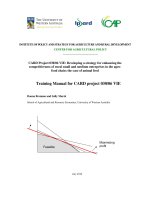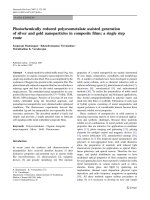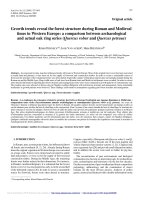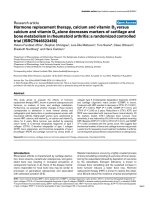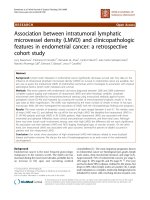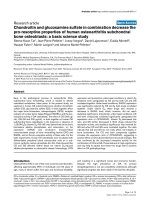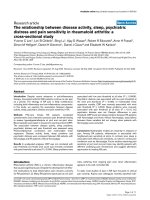Soft prosody and embodied attunement in therapeutic interaction a multimethod case study of a moment of change
Bạn đang xem bản rút gọn của tài liệu. Xem và tải ngay bản đầy đủ của tài liệu tại đây (717.74 KB, 50 trang )
This is an electronic reprint of the original article.
This reprint may differ from the original in pagination and typographic detail.
Author(s): Kykyri, Virpi-Liisa; Karvonen, Anu; Wahlström, Jarl; Kaartinen, Jukka; Penttonen,
Markku; Seikkula, Jaakko
Title:
Soft Prosody and Embodied Attunement in Therapeutic Interaction: A Multimethod
Case Study of a Moment of Change
Year:
2017
Version:
Please cite the original version:
Kykyri, V.-L., Karvonen, A., Wahlström, J., Kaartinen, J., Penttonen, M., & Seikkula, J.
(2017). Soft Prosody and Embodied Attunement in Therapeutic Interaction: A
Multimethod Case Study of a Moment of Change. Journal of Constructivist
Psychology, 30 (3), 211-234. doi:10.1080/10720537.2016.1183538
All material supplied via JYX is protected by copyright and other intellectual property rights, and
duplication or sale of all or part of any of the repository collections is not permitted, except that
material may be duplicated by you for your research use or educational purposes in electronic or
print form. You must obtain permission for any other use. Electronic or print copies may not be
offered, whether for sale or otherwise to anyone who is not an authorised user.
SOFT PROSODY AND EMBODIED ATTUNEMENT IN THERAPEUTIC INTERACTION
1
Soft Prosody and Embodied Attunement in Therapeutic Interaction: A Multi-method Case Study
of a Moment of Change
Accepted for publication in the Journal of Constructivist Psychology (Editor’s decision letter:
24-Apr-2016)
Authors:
Virpi-Liisa Kykyri, Ph.D.
Anu Karvonen, M.A.
Jarl Wahlström, Ph.D.
Jukka Kaartinen, Ph.D.
Markku Penttonen, Ph.D.
Jaakko Seikkula, Ph.D.
University of Jyvaskyla, Department of Psychology, Jyvaskyla, Finland
Author Note
Virpi-Liisa Kykyri, Department of Psychology, University of Jyvaskyla
Virpi-Liisa Kykyri, P.O. Box 35, FI-40014 University of Jyvaskyla, Finland.
SOFT PROSODY AND EMBODIED ATTUNEMENT IN THERAPEUTIC INTERACTION
2
Soft Prosody and Embodied Attunement in Therapeutic Interaction: A Multi-method Case Study
of a Moment of Change
In the social sciences and in psychotherapy research there has been increasing interest in the
relational, affective, and embodied aspects of interactions (Cromby, 2012; Stern, 2004).
Everyday experiences of affective attunement, which include achieving a connection with
another person or sensing another person’s feelings, are deeply embodied. It is highly likely that
such experiences are clinically relevant, contributing to the construction of new personal
meanings, which is a core element of therapeutic change. Thus, within constructivist
psychotherapy, the manifestation of emotion is seen as pointing to an increase in the client’s way
of experiencing something; hence, a legitimate rule for a clinician is to “follow the affect trail”
(Neimeyer, 2009). Nevertheless, there are problems in studying attunement, bearing in mind that
during interactions people tend to adapt to others in ways that they are not even aware of.
Affective attunement between two or more persons is assumed to happen intuitively, largely
below conscious monitoring. Embodied experiences emerge and become sensed within a very
short period of time, the “present moment” (Stern, 2004). They can exist as barely perceptible
glimpses, but also as more striking experiences of intense emotionality, such as anger or sadness
(Harré, 1986).
The concept of embodied attunement is rooted in developmental psychology. At the start of
life, communication occurs mainly at the bodily level, consisting of concrete actions, such as
vocal cues and mimicry, and also “perceptional qualities” or “vitality contours” such as timing,
SOFT PROSODY AND EMBODIED ATTUNEMENT IN THERAPEUTIC INTERACTION
3
form, and intensity (Stern, 1985). These behavioral dimensions carry important relational
information and are regulated in mutual interaction, within which the various attributes,
including prosodic elements of speech, are turned into forms of feeling. Stern (1985) calls this
process “affect attunement,” and has proposed it as the basis of intersubjectivity in all human
interaction. Experiences of embodied attunement consist of (i) a complex mixture of observable
synchrony, i.e. similar verbal and nonverbal behaviors in the realm of micro-level social
interaction, encompassing similar bodily responses that occur in a coordinated manner within a
particular moment (Barrett, 2012), and (ii) non-observable elements such as bodily sensations,
feelings and (vague) impressions or anticipations of how things are in a relationship, or how the
ongoing interaction is developing (Shotter, 1993). The multi-layered nature of such experiences
means that embodiment research calls for advanced designs and for approaches using mixed
methods (Cromby, 2012).
The present study focused on the changes in prosody (i.e. the musical and embodied
elements in speech) occurring in the course of one highly emotional episode within a
psychotherapy dialogue between a client, a therapist, and a psychology student, who participated
in this psychotherapy case as part of her studies. The aim of the study was to contribute to
research on embodied attunement by presenting a case in which psychophysiological measures
and interviews were utilized along with a qualitative analysis of social interaction. By this means
we sought to determine how patterns of interaction – including what we have termed “soft
prosody” – were related to the participants’ bodily responses and to the interpretations they gave
to the interaction in question.
SOFT PROSODY AND EMBODIED ATTUNEMENT IN THERAPEUTIC INTERACTION
4
The present study is part of a research project called the Relational Mind in Events of
Change in Multiactor Therapeutic Dialogues (Seikkula et al, 2015), which, to our knowledge, is
the first to use a multi-actor psychotherapy interaction as a natural laboratory for studying the
changes in bodily activity that occur during social interaction. The aim in the project is to focus
on the comprehensive embodied flow of responsive events in dialogue between participants
(Bakhtin, 1984; Seikkula, 2011). Drawing on intersubjectivity research (Stern, 2004; Trevarthen,
2001), the project aims to explore how emotions are communicated and negotiated, how
empathy and compassion are performed, and how this may lead to affective regulation,
exploration, and mutual change. The project seeks to integrate information on how clients and
therapists synchronize their behavior with each other, not merely in dialogue, but also in their
body movements and gestures, and in their autonomic nervous system (ANS) responses. While
we acknowledge the importance of language and conversation as means by which people
accomplish relational outcomes (Heritage, 1984; Strong et al., 2008), our focus is also, and
equally, on participants’ bodily responses, with the aim of discovering how bodily changes
connect to processes of meaning-making in social interaction (Cromby and Nightingale, 1999;
Lyons and Cromby, 2010). In addition, we are interested in the individual meanings and
interpretations that participants give to interactions and experiences.
The ANS is a mediator of emotional reactions, and measures of the sympathetic activation,
especially skin conductance (SC) and heart rate (HR), are well established correlates of
emotional responses (Lang et al., 1998). Increased electrodermal activity, as measured by
increased skin conductance responses (SCR) and the skin conductance level (SCL), has been
SOFT PROSODY AND EMBODIED ATTUNEMENT IN THERAPEUTIC INTERACTION
5
reported to occur with most emotions (Kreibig, 2010). Since psychophysiological responses are
integral elements of emotional experiences, and since they may derive from mental states that are
not observable in overt behavior or in verbal reports, they can give useful information on the
affective aspects of an interaction.
In the project in question, individual Stimulated Recall (SR) interviews (Kagan, Krathwohl,
& Miller, 1963,) also referred to as Interpersonal Process Recall (Elliott, 1986,) are conducted
after the sessions. In these, clients and therapists are asked about their thoughts, feelings,
impressions, and bodily sensations during the interaction under study. In the course of the
interviews, video-taped extracts from the therapy session are used to facilitate the recall of the
participants’ subjective experiences. Although such experiences cannot be fully described in
words, and although parts of the descriptions consist rather of reflections provoked by the
extracts, individual interviews can provide important information, especially in relation to
emotional moments of the interaction, since the emotions themselves often facilitate memorizing
and recall (Sandi and Pinelo-Nava, 2007). In individual interviews, participants often share and
comment on relevant issues, such as thoughts and feelings that they did not express during the
actual interaction. Here it should be noted that there can be marked differences in participants’
experiences of the same interaction, and in the interpretations given to them.
The present study originated from an observation of a moment of attunement within a
psychotherapy session between one client, a therapist, and a student. In this episode, the client
was weeping while she talked about painful experiences in her life. The impression of
attunement was strong and consisted mainly of silences and gentle ways of talking. We became
SOFT PROSODY AND EMBODIED ATTUNEMENT IN THERAPEUTIC INTERACTION
6
interested in this kind of interaction, encompassing what we here refer to as “soft prosody,” i.e.
the interlocutors’ use of pauses, a lower volume, a slower rhythm, and a lower-pitched and more
level intonation than in the surrounding speech. Later, a detailed analysis of the social interaction
suggested that this episode also comprised a moment of therapeutic change in personal
meanings. From inspection of the heart rate (HR) measurements conducted during the session, it
emerged that for the client, this episode had, in physiological terms, been the most stressful
moment of the entire session.
On the basis of these aspects, we concluded that the episode in question would offer rich
material to study the multi-layered phenomenon of embodied attunement in psychotherapy
interaction. We decided to focus on the use of soft prosody as an element of the observed
attunement and of changes in meaning-making. In addition, we were interested in whether and
how the signs of attunement in the interaction might be reflected in the participants’
psychophysiological responses.
In everyday social interaction, information on the speaker’s emotional state is conveyed
through resources that include facial expressions, body movements and gestures, verbal
expressions, and elements that combine the expression of emotion and action, such as laughter
and crying (Peräkylä & Sorjonen, 2012). Moreover, the prosodic features of speech, such as
pitch, tempo, loudness, and pauses, affect the ways in which what is said is received by
interlocutors. Such features are central elements which interlocutors modulate in conveying and
receiving emotions in an interaction (Couper-Kuhlen & Selting, 1996; Szczepek Reed, 2011).
SOFT PROSODY AND EMBODIED ATTUNEMENT IN THERAPEUTIC INTERACTION
7
The present study focused on what we call “soft prosody.” This is definable in terms of the
following characteristics:
(i) the use of a low volume voice in the interaction. In everyday life, in conjunction with
other prosodic phenomena, low-volume sounds are generally felt to be friendly and soothing;
(ii) the use of certain types of intonation, characterized by a low pitch and a reduced pitch
range. In conjunction with low volume, these form an important element in a “softer” tone of
voice, as referred to by Weiste and Peräkylä (2014);
(ii) the use of continuers, nods, and various facial expressions. The most common means of
displaying affiliation, i.e. showing empathy and attempting to enter into a teller’s unhappiness,
include the use of continuers, e.g. “mm,” “yeah” (Schegloff, 1982), nods (Stivers, 2008), and the
showing of an affiliative (i.e. compassionate, caring) change in one’s facial expression (Peräkylä
& Ruusuvuori, 2012).
(iii) Pauses are important ingredients of soft prosody. There is considerable variation in how
silence is sensed, depending on the situation in which silence occurs. As noted by Johannesen
(1974, 26), “silence takes on meaning only in a surrounding context of verbal and nonverbal
symbols.” Silence can be sensed as relaxing and comforting, and it can convey respect and
compassion; however, it can also be sensed as uneasy or even frightening, or as an exercise of
power. In psychotherapy, silence is often seen as a desirable element of the interaction, and one
that can be a pathway to displays of affiliation and empathy (Hill, Thompson, & Ladany, 2003).
According to Levitt (2001), on the basis of clients’ experiences of silences in individual
psychotherapy, silences can be divided into neutral, productive, and obstructive types of silence.
SOFT PROSODY AND EMBODIED ATTUNEMENT IN THERAPEUTIC INTERACTION
8
There is some evidence that there are more emotional, self-expressive, and reflective types of
productive silences and fewer disengaged types of obstructive silences in the good-outcome
psychotherapy dyads than in the poor-outcome dyads (Frankel et al., 2006).
The present study is related to a long tradition of studies on important moments in
psychotherapy, which are often called as “significant moments” (Elliott, 1985; Elliott & Shapiro,
1992). Research in the area has touched on clients’ and therapists’ perceptions of helpful or
hindering moments, and on their possible productive role in the therapeutic processes (Timulak,
2007; 2010). There is some evidence that the relational and emotional aspects of an interaction
may be crucial in significant moments of psychotherapy, and that clients may find these more
important than the cognitive aspects of therapy that are more frequently highlighted by therapists
(Timulak, 2010). On the basis of such findings, emotional aspects and attunement would appear
to be relevant elements in significant moments of psychotherapy. Nevertheless, to our
knowledge, research on significant moments has not paid much attention to the embodied aspects
of interaction.
Even though empirical research on embodied attunement in clinical practice remains rare,
some important observations have been made. Ramseyer and Tschacher (2011) found that
synchronization of body movements may increase the experience of a good working alliance and
contribute to a better outcome in therapeutic dyads. They observed that clients’ experience of the
session was related to this synchronicity. Observations of embodied attunement have also been
conducted by focusing on the facial expression of emotions during psychotherapy interactions
(Bänninger-Huber & Widmer, 1999; Benecke, Peham, & Bänninger-Huber, 2005; Darwiche et
SOFT PROSODY AND EMBODIED ATTUNEMENT IN THERAPEUTIC INTERACTION
9
al., 2008). Marci, Ham, Moran, and Orr (2007) studied client and therapist dyads and found that
client-perceived empathy was connected to good mutual concordance in skin conductance (SC)
between the participants.
Dialogical practice and research have indicated that therapists synchronize their talk with
the clients, for example by repeating the client’s utterances and by integrating their own
utterances with these. This in turn contributes to the therapeutic relationship and to the clients’
experiences of it (Seikkula & Arnkil, 2014). There is some evidence that clients tend to be more
responsive to how things are being said in psychotherapy, rather than to the content of the
therapist’s utterances (Quillman, 2012). Lapides (2011) found that during emotionally tensed
moments of a relational conflict, clients in couple therapy attend primarily to prosody, and also
to body posture, gesture, and facial expressions. Geller and Porges (2014) have suggested that
prosodic and other non-verbal elements of emotional interaction may have a central role in
communicating safety and in creating a “therapeutic presence,” i.e. the perception that a therapist
is wholly engaged in and attuned with and for the client. Imel et al. (2014) found strong evidence
for vocal synchrony in clinical dyads, as well as an association between synchrony and client
empathy ratings. On the basis of these observations, they suggested that synchrony in
physiological arousal could be mediated in part via vocal cues. Drawing on the work of Rice and
Kerr (1986), Tomicic, Martinez, and Krause (2015) used a Vocal Quality Pattern (VQP) coding
system to study the process of change in psychodynamic psychotherapy; they found that the
process was embodied in the expressive vocal styles of the participants.
SOFT PROSODY AND EMBODIED ATTUNEMENT IN THERAPEUTIC INTERACTION
10
Weiste and Peräkylä (2014) observed that therapists’ formulations which led up to the
validation of clients’ emotions were characterized by prosodic continuity, meaning that they
were produced with a similar prosody to that of the client’s preceding turn. They found that the
therapist also lowered her/his voice, spoke quietly, and used level intonation. The clients treated
these formulations as validating, and as permission to feel what they felt. By contrast,
formulations that led up to a challenge to the client’s emotions were characterized by prosodic
disjuncture: the therapist’s prosody was different from the client’s previous prosody, the pitch
span in the therapist’s turn was wider, and the therapist spoke with a voice that was higher and
louder than the client’s prior talk. The clients oriented themselves to these challenging
formulations by viewing them as problematic; they might confirm them only partially, or reject
them (Weiste & Peräkylä, 2014).
Our first attempts (Seikkula et al, 2015) to study embodied attunement in couple therapy
showed some clear psychophysiological responses, such as high stress, occurring in
chronological coordination with important interactions in the session. We also discovered that
attunement is often not a simple “all at the same time” phenomenon, but rather a complex
phenomenon which changes over time. Thus, during a specific moment, one client can have a
strong sympathetic synchrony with one therapist, but later in the session, the client can have
more synchrony with another participant. The same design was used to study the significance of
silent moments and soft prosody in one couple therapy session (Itävuori et al, 2015). From our
analysis of the social interaction and of the participants’ ANS responses, we noticed that even
during moments with less overt vocalization, the participants were able to continue their
SOFT PROSODY AND EMBODIED ATTUNEMENT IN THERAPEUTIC INTERACTION
11
conversation on fundamental issues, such as the permanence of the relationship and the possible
separation of family members, both through their bodily responses and through soft prosody.
These initial findings encouraged us to focus on specific episodes of the interaction; they
indicated that soft prosody could have an important role in promoting embodied attunement
within a psychotherapy interaction.
The design of the present study provided a rare opportunity to integrate information from
several channels of interaction, namely (i) the therapeutic conversation within an important
psychotherapy event, (ii) prosodic and other nonverbal elements of an interaction (regarded as
more embodied elements of spoken language than the actual words), (iii) psychophysiological
responses (as observed in parallel Autonomic Nervous System (ANS) measurements) during
visible emotional expression (weeping), and (iv) participants’ personal experiences (thoughts and
feelings) from the episode, as they were reported in individual interviews conducted after the
therapy session. We applied a multi-method approach with precise timing, aiming to explore (i)
how soft prosody was used during one emotionally intense psychotherapy episode in which
painful issues were processed, and (ii) whether and how this contributed to embodied attunement
between the participants, and to therapeutic change. Our basic assumption was that soft prosody
plays an important role in how the interlocutors experience mutuality and sharing within the
relationship. On the basis of the intense emotionality during the episode, we expected to find
responses in the participants’ ANS as measured via SC and HR. We wished to discover whether
there would be signs of synchrony in the participants’ ANS, since these could indicate embodied
attunement between the participants. Finally, we were interested to see how interactional patterns
SOFT PROSODY AND EMBODIED ATTUNEMENT IN THERAPEUTIC INTERACTION
12
in the episode were related to patterns of bodily synchrony and to the participants’ interpretations
of the interaction.
Method
The Relational Mind research project is part of the research programme The Human
Mind (Academy of Finland), and it is conducted at the University of Jyväskylä, Finland, in
collaboration with five international partners. Within the project, data are gathered at the
Psychotherapy Training and Research Center of the University of Jyväskylä. So far, the data
consist of one individual psychotherapy case and twelve couple therapy cases. The Ethical Board
of the University of Jyväskylä has approved the research, and all the participants have given their
informed written consent.
The Case and Design
The data for this study were from a case with one female client and an experienced
psychotherapist, and also a psychology student. When the client contacted the psychotherapy
center she had self-defined her presenting problem as depression. She was an unemployed single
parent. She indicated that she had serious problems in her relationships with her parents and
friends. There were six sessions altogether, with the data for the present study coming from the
third session. Progress in therapy was monitored by the Outcome Rating Scale (ORS), given to
the client before each session, and by the Session Rating Scale (SRS) (Miller & Duncan, 2004),
SOFT PROSODY AND EMBODIED ATTUNEMENT IN THERAPEUTIC INTERACTION
13
given to the client and also to the therapist and the student after each session. In the third session,
the SRS score for the client was 37.9 (with 36 illustrating an ideal working alliance) and the ORS
score (indicating the amount of psychological distress) was 20.9 (the clinical cut-off being 25 or
below). In the sixth session, the ORS score was 35.8, indicating a significant change for the
better.
The participants were recorded using two cameras. These showed the entire setting on a
split screen (therapist/student/client). In addition, a precise facial image of every participant was
recorded using three additional cameras. During the third therapy session, the therapist, the
student, and the client all wore the following ANS measuring equipment: (i) As a measure of
electro-dermal activity (EDA), skin conductance (SC) was registered with two electrodes
attached to the non-dominant palm. (ii) Respiration was measured with a fabric belt fastened
around the lower chest. (iii) There was continuous heart rate monitoring, starting a day before the
therapy session, continuing during the therapy session, and ending after the SR interview. The
SR interviews were recorded with two cameras: one recorded the facial expressions of the
interviewee (client, or therapist, or student) while the other included the whole setting. During
these latter interviews, finger pulse volume and bodily movements were also recorded. The heart
rate was recorded with Firstbeat Bodyguard equipment, using two disposable electrodes attached
to the chest. Other ANS activities were collected via BrainProducts sensors and data acquisition
systems.
The SR interviews were conducted three to four hours after the third therapy session. During
the interviews, a researcher met all three participants, one at a time, to show them four video
SOFT PROSODY AND EMBODIED ATTUNEMENT IN THERAPEUTIC INTERACTION
14
extracts encompassing two- to four-minute episodes from the therapy session. The researcher
interviewed the participants concerning the thoughts and feelings they had experienced during
these episodes. All the participants watched the same extracts, which the researcher had selected
on the basis of: (i) visible emotional expression, (ii) notable changes in social interaction (such as
dialogue after several monologues), (iii) changes in skin conductance (i.e. a strong response from
one participant, or changes that indicated the synchronization of two or more participants), or
(iv) a combination of these. The individual interviews lasted about 35–40 minutes per
participant. The participants were encouraged to share their thoughts at any time while watching
the extracts.
One conversational episode within the third therapy session was selected for detailed
analysis in the present study. This 91-second episode occurred in the middle of the session (from
19 min. 29 secs. to 21 min.). This episode was selected for further analysis on the following
grounds:
(i) The episode consisted of the following elements: expressing and receiving emotions,
conveying empathy, offering formulations, and showing awareness and insight. With all these
elements in place, the episode was considered to represent an important psychotherapeutic
moment.
(ii) It was rich in incidences of soft prosody, i.e. the interlocutors’ use of pauses, a lower
volume, a slower rhythm, and lower-pitched and more level intonation than in the surrounding
speech.
SOFT PROSODY AND EMBODIED ATTUNEMENT IN THERAPEUTIC INTERACTION
15
(iii) It involved strong visible emotions, and was therefore of interest from a
psychophysiological perspective.
(iv) The HR variables indicated that the episode contained the client’s highest physiological
stress of the entire session.
(v) Individual interviews concerning the participants’ experiences of the episode were
available.
Analysis
The video-recorded therapy session and the interviews were transcribed verbatim, using detailed
notations to indicate interactional features (see Appendix 1). The original Finnish-language
recordings and transcriptions were used in the various stages of the analysis. The extracts
selected for this article were translated into English after the overall analysis. The Finnish
transcripts are available on request from the first author.
The first author conducted the detailed analysis of the social interaction in the selected
episode, focusing on both the contents of the speech and the prosodic and other non-verbal
elements of the interaction. Thereafter, the third author watched the extracts and commented on
the analysis, which was then further elaborated on the basis of his observations. The analysis was
informed by ideas from conversational analysis (Goffman, 1979; Sacks, Schegloff, & Jefferson,
1974; Silverman & Peräkylä, 1990), and discursive psychology (Edwards & Potter, 1992; Potter,
2003). Particular use was made of methods for analyzing prosody (Couper-Kuhlen &Selting,
1996; Barth-Weingarten et al., 2010) and emotions (Peräkylä & Sorjonen, 2012) within
SOFT PROSODY AND EMBODIED ATTUNEMENT IN THERAPEUTIC INTERACTION
16
interactions. In addition, the concept of footing (Goffman, 1979) was used. This refers to the
ways in which shifts in the alignment of the speaker and the listener are used as a resource, for
example in situations when one participant starts to speak on behalf of another, taking on the
other’s voice or perspective.
The second author conducted a separate analysis of the HR data to define stressful moments
from the session as a whole. The Firstbeat Bodyguard (Firstbeat Technologies) recording device
makes it possible to obtain second-by-second calculations of stress and relaxation, thus reflecting
the activity of the sympathetic (absolute stress vector, ASV) and parasympathetic (absolute
relaxation vector, ARV) nervous system (e.g. Kinnunen et al., 2006). The ASV is calculated
from respiratory variables derived from the HR, high frequency power (HFP), low frequency
power (LFP), and HRV-derived respiratory variables. The algorithm is based on the principle
that the ASV is high when the HR is elevated, HRV is reduced, and the respiration rate is low
relative to the HR and HRV.
To detect possible signs of bodily synchrony during the selected episode, correlations were
calculated between the participants’ skin conductance responses (SCR). SC recordings were
down-sampled to a 1s sampling interval, slopes for successive values were calculated, and each
value was replaced with a 5s moving average in order to remove small amounts of amplitude
noise from the signal. Pearson correlations were then calculated between the participating pairs
(client to therapist, client to student, therapist to student). SC raw data were used to determine
whether the participant’s arousal level (based on the SC) was increasing or decreasing.
SOFT PROSODY AND EMBODIED ATTUNEMENT IN THERAPEUTIC INTERACTION
17
The transcribed SR interview responses of the therapist, the student, and the client were then
thematically analyzed by the first author. Within the analysis, all comments in which a
participant clearly referred to the selected episode were included, whether they occurred after
seeing this particular episode or at another moment during the SR interview. The participants’
individual interviews were used to complete, modify, or confirm the findings.
Finally, the findings of the separate analyses were integrated to produce a multi-layered
description of the interaction in the episode.
Results
In this Results section we first present a transcription and analysis of the social interaction in the
selected episode. Thereafter we present the corresponding ANS data, and finally observations
from the SR interviews.
In the extract, the client is marked as C, the therapist as T, and the psychology student as S.
Since the client’s highest ASV peak during the entire session occurred during the selected
episode, it is marked in the transcript as, for example, ((client’s ASV starts to rise)), and
commented on along with the analysis of the social interaction.
The Interactional Episode
SOFT PROSODY AND EMBODIED ATTUNEMENT IN THERAPEUTIC INTERACTION
18
In this session, the client talked about her disappointment at not finding any job despite her new
degree, and her struggle to get good grades in it. She started to talk about painful and abusive
experiences in her relationships with friends and relatives. She felt that she had been used by
others for different purposes, and that this experience had lasted a long time. The client
specifically named her father, sister, and a close friend, who had frequently asked her to do
various tasks for them, but who had shown no willingness to help the client in return. Particularly
during her studies, the client had felt that she would have needed help and support, but had not
received any. In talking about these experiences, the client started to express her unhappiness by
weeping and looking sad.
Extract 1:
1. C:
it feels bad now when I notice what is going on
2. T:
°yes°
3. C:
mm ((nods, wiping tears from her cheek))
4. T:
@earlier you did not notice it (1) and well (.) the exploitation just then
5.
((gentle voice, gestures with hand))(.) continued@
6. C:
.hh yes (.)((wiping tears)) continued ((nods))
7. T:
mm
8. C:
so that I must just be le- kind of mo- (.) to a smaller extent in contact ((with
9.
them)) so that I (.) kind of myself (.)
10. T:
mm
11. C:
feel OK((nodding)) (1)
SOFT PROSODY AND EMBODIED ATTUNEMENT IN THERAPEUTIC INTERACTION
19
In extract 1, the client’s emotionality enters the interaction, and she wipes tears from her
cheek (lines 3, 6). The therapist uses soft prosody (lines 4–5) and continuers (lines 7 and 10) in
displaying emotional affiliation with the weeping client.
Earlier in the conversation, the client had mentioned that at first she had not noticed how she
was being exploited by her family and friends. In line 1 she indicates that becoming aware of
how she was used makes her feel bad. The therapist’s formulation in lines 4–5 repeats the
client’s earlier utterances and focuses on the notion that this relationship pattern has continued.
The client confirms this in line 6. The therapist responds to this with the continuer “mm” (line 7).
The client seems to treat this as an invitation to say more. The client says that from now on, she
must avoid those who made use of her earlier (lines 8–9 and 11).
Extract 2:
12. T:
.hhh ((gestures with hand)) ↓but is it so that now that you ↑see it that you have
13. C:
((wiping tears))
14. T:
been used in those relationships then ((looks at T2)) from that comes ((looks at
15.
C)) (.) @that bad feeling of having been undervalued ((nods)) and °not
16.
respected°@ ((gentle voice)) (1) which was ↑not ((gestures away from the client))
17.
there earlier (.)@°or was it ((the bad feeling)) there even then°@ ((gentle voice))
((client’s ASV starts to rise))
SOFT PROSODY AND EMBODIED ATTUNEMENT IN THERAPEUTIC INTERACTION
20
The therapist pays no attention to the client’s idea of being less in contact with her relatives
(see lines 8–9), and instead offers another formulation (starting from line 12) which focuses on
the previous topic, i.e. the client’s bad feelings. Lexically, this repeats and summarizes the
client’s earlier utterances, but at the same time, it forms a significant conversational choice, in
that it highlights and emphasizes some of the client’s utterances, but passes over some other parts
of her speech. This choice seems to work as a delicate and indirect suggestion for the client to
live through this emotion (bad feeling), rather than as creating ways of avoiding it. The
therapist’s formulation is offered as a question. There is a rising intonation on the words “see”
(line 12) and “not earlier” (lines 16–17), which focus the therapist’s question on the client’s
claim that she had not noticed the pain earlier. The client continues to weep, and wipes tears
from her cheek (line 13). As can be seen in line 15, the therapist uses soft prosody when referring
to the client’s experiences of being “undervalued” and “not respected.” Soft prosody is used
again in line 17, when the therapist articulates, almost in a whisper, “or was it ((the bad feeling))
there even then.” The therapist’s question very gently challenges the client’s idea of having been
ignorant of her bad feelings earlier. Here the use of soft prosody seems to downgrade, not to
upgrade, the therapist’s idea. It appears that by doing this, the therapist is displaying sensitivity
to the delicate nature of this conversational domain, and conveying affiliation with the weeping
client. At the same time, he empathetically challenges the client’s idea by inviting the client to
engage in emotional experiencing, and by refocusing the client’s emotion. As marked in line 17,
the client’s stress vector starts to increase during the therapist’s second formulation, and this
increase continues during the following extract (Extract 3).
SOFT PROSODY AND EMBODIED ATTUNEMENT IN THERAPEUTIC INTERACTION
21
Extract 3:
18. C:
((wiping tears)) well that was a time of try- then I was trying
19. T:
((coughs)) yeah
20. C:
I was trying that (.) to be the ((turning her head from side to side)) the right kind
21.
((of person)) [or something like that
22. T:
[((nods))
23. T:
yeah
24.
(3)
25. C:
now I think this ((wiping tears)) sorrow has to come out (.)
26. T:
↑mh ((nodding))
27. C:
so that somehow I ↑must see (.)
28. T:
mm
29. C:
this pain means the same as seeing
30. T:
mm
31. C:
or does it ((laughs))
The client’s turn (in lines 18–21) indicates that she notices the challenging content in the
therapist’s second formulation (shown in extract 2). She treats the therapist’s turn as a question
and appears to see herself as having to account for not having been aware of the exploitation: “it
was a time of trying.” She has tried to solve this situation by “trying to be the right kind ((of
person)).” There is a three-second pause (line 24) after the therapist’s nod (line 22) and “yeah”
SOFT PROSODY AND EMBODIED ATTUNEMENT IN THERAPEUTIC INTERACTION
22
(line 23), which can be seen as a means of displaying emotional affiliation with the weeping
client.
Wiping tears from her cheek, the client says that now it is time for sorrow (line 25). Thus,
what the client has earlier called a bad feeling is now renamed as sorrow. The therapist displays
emotional affiliation by nodding and using the continuer “mm” (line 26). This minimal response
is expressed with high intonation, and the client treats it as an invitation to say more by
responding that she “must see” it now, possibly referring to the abusive pattern in her
relationships (line 27). After another “mm” on the part of the therapist, the client continues by
sharing her (somewhat vague) idea that feeling “pain” would mean the same to her as “seeing”
(line 29). What was previously called a bad feeling and recently renamed as sorrow is now
renamed by the client as pain. The therapist again responds with a continuer. The client
laughingly asks (line 31) “or is it,” thus seeking the therapist’s confirmation of her idea. The
therapist responds to this with a gentle voice and a smile (Extract 4, line 32).
Extract 4:
32. T:
@well ((with a gentle voice, smiling and looking at the client))
33. C:
mm
34. T:
.hh so you have@ (.) very (.) ↑co(h)nciously like
35.
chosen it [(.)((client’s highest ASV peak, starts to decrease))
36. C:
[yea:h
37. T:
that (.) well this (.) can’t ((looks at S, gestures with his hand)) go on
38.
any more ((looks at the client)) and (.) now I’m ((points to the client with his
SOFT PROSODY AND EMBODIED ATTUNEMENT IN THERAPEUTIC INTERACTION
23
39.
hand)) doing differently and (.) °then it feels painful° ((with a gentle voice))
40. C:
mm (.) but this is how it must be ((wiping tears)) (.) because
41.
↑there is no return to the past ((laughs))
The therapist again uses soft prosody when offering his third formulation (starting from line
32). It differs from the others by being not a question but a statement. A soft and gentle, even a
whispering voice is used both in preparing (“well,” line 32) and ending (“°then it feels painful°,”
lines 37–38) his formulation, which not only cites the client’s earlier words, but also highlights
the client’s active role in choosing her ways to deal with the situation. This is done mainly by
lexical choices and by changes in footing. First of all, the therapist uses the pronoun “you” (line
34) when referring to the choice that the client has “consciously” made. Secondly, he changes
the footing, while repeating the client’s talk, by using the pronoun I in “now I’m doing
differently” (line 38), even though it is obvious that the therapist is not referring to himself but to
the client. This is confirmed in the therapist’s gesture, which points to the client. This carefully
designed formulation positions the client as an active agent who considers what is best for
herself, even if it means experiencing pain. The client confirms this (lines 40-41) by saying
laughingly that “there is no return to the past.” Thus, there is an overall movement in these 41
lines, from “a bad feeling” (line 1) to “sorrow” (line 25) to “pain” (line 29), with the client
recategorizing this in terms of being finally able to “see” (line 29) that this is “how it must be”
(line 40). The client’s stress vector reaches the highest peak of the entire session in line 35 and
then starts to decrease very rapidly.
SOFT PROSODY AND EMBODIED ATTUNEMENT IN THERAPEUTIC INTERACTION
24
Extract 5:
42. T:
mm
43. S:
mm
44. C:
((wiping tears, sniffs)) mm
45.
(4)
46. T:
mm (.) mm ((nodding))
47. C:
((clicks her tongue)) I must become ((points to herself))
48.
°stronger ° ((with a gentle voice)) inside (.) not just superficially
49.
(7)
50. T:
((nodding)) stronger inside
51. C:
yeah (.) throughout this pain
52. T:
yes ((looks at the client gently with a smile))
53. C:
nn
54. T:
((nodding))
55.
(3)
After the client’s turn, the therapist, the student, and the client give minimal responses
“mm,” the client wipes tears from her cheek, and there is a four second pause. In line 46, the
therapist nods and gives another minimal response. In line 48, the client says that she needs to
become “stronger inside.” Interestingly, the client pronounces the word “stronger” in a very
warm and gentle tone and with lower volume than in the surrounding talk. It seems that the client
has adopted the therapist’s way of talking when she addresses speech to herself, thus displaying

